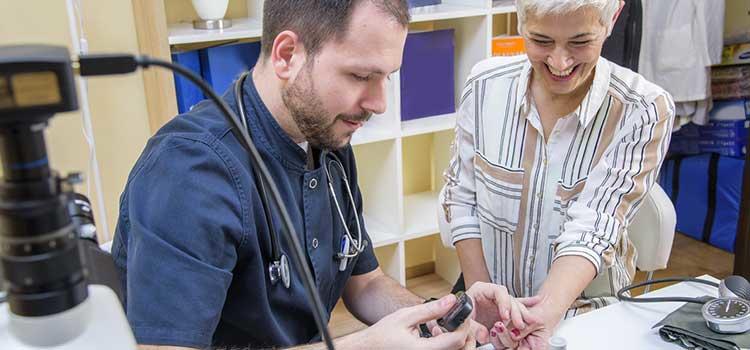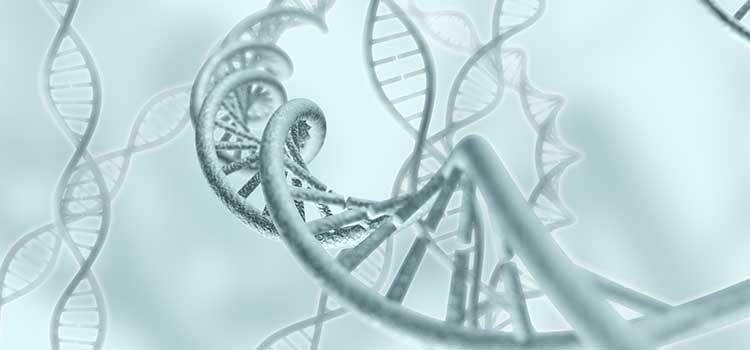Feb. 18, 2017
The fight against cancer: Early detection is key
Cancer isn’t just a matter of professional curiosity to University of Calgary researchers Dr. Kristina Rinker, PhD, and her husband, Bob Shepherd.
Even as they helped begin work on a better way to detect breast cancer, a good friend was diagnosed with the disease.
“That really drove it home,” says Rinker, who is director of the Centre for Bioengineering Research and Education at the university’s Schulich School of Engineering. Breast cancer had already touched both Rinker and Shepherd through their families: Rinker’s grandmother suffered from the illness, as did Shepherd’s grandmother and mother.
"I think just about everybody knows somebody that’s been affected by cancer."
About 25,700 women in Canada were expected to be diagnosed with breast cancer in 2016, with about 4,900 dying of the disease. It also likely affected about 230 men, killing about 55.
“I think just about everybody knows somebody that’s been affected by cancer,” says Rinker. “I wasn’t a cancer researcher when I began this, but I saw a potential opportunity to come at the problem from a completely different direction that could actually help people get diagnosed earlier and get better treatment.”
Diagnostic kits for breast cancer
Rinker is a co-founder of Syantra, Inc., a Calgary-based company that has Shepherd as its chief technology officer. Syantra plans to market a breast cancer diagnostic kit that screens blood samples for evidence of the disease. It looks for chemical traces or biomarkers of molecules called mRNA (messenger ribonucleic acid), which carry the instructions from a cell’s DNA to create proteins.
Less than a tablespoon of blood can contain enough mRNA from cancer cells to be usable, says Shepherd, who is also a research associate at the Schulich School of Engineering. Test results are sifted by a sophisticated algorithm created using bioinformatics (an interdisciplinary field that applies everything from statistics to computers to better understand biology) and computer techniques, such as machine learning, that are used in artificial intelligence.
“Without the algorithm, you don’t get the correct information,” says Rinker, who is also an associate professor at the Cumming School of Medicine and a member of the school’s Alberta Children’s Hospital Research Institute and the Libin Cardiovascular Institute of Alberta. “This is the ‘math’ that takes the raw data and converts it into an output that clinicians can use to help inform their decisions.”
The diagnostic kit was originally conceived for use in individuals who had already been diagnosed with breast cancer, to help determine the risk of that cancer progressing. But as the team looked at the data, it became clear that they had a way to screen for breast cancer in all women.
The research project arose from a visit to the university in 2011 by a South Korean delegation that included Yonsei University researcher Hyeyoung Lee, who later helped co-found Syantra. The visit sparked a formal collaboration with Lee’s team — supported with funding from the Life Science Industries Office in the Alberta government — who helped provide patient samples and assisted with the identification of biomarkers and the creation of cancer tests.
The kit is expected to be available in the European Union by the latter part of 2017, says Rinker. After completing several regulatory steps, including a study planned to get underway in 2017 using Calgary- and Edmonton-area patients, the kit could be available in Canada during 2018, she says.

.
Many uses possible
Initial use of the kits is currently being discussed in Alberta, says Shepherd. Options include assessing the need for low-risk patients with a breast lump to undergo a biopsy, or using the kit on women under 50, who tend to have denser breast tissue that makes mammograms less effective.
The kits could eventually present an alternative to mammography, offering similar or better accuracy while eliminating exposure to radiation from X-rays. They could be implemented as part a patient’s yearly physical, says Shepherd, or they could be used to examine people before they begin to notice any physical changes in their breasts, catching any cancer before it spreads and becomes harder to eradicate.
The test could also be used to pinpoint the exact type of breast cancer, allowing physicians to combine the test with new, specifically tailored treatments instead of less-specific methods, such as chemotherapy, that affect the whole body. “An important consideration is to identify individuals who need more aggressive treatment versus those who don’t,” says Shepherd. “Being able to accurately and quickly make that call can have a large impact on the care pathway and patient outcomes.”
Screening for other types of cancer
The company is also conducting preliminary work that could lead to the first blood screening test for lung cancer, says Shepherd. “We're going to use what we learned from the breast cancer test and follow that path.”
Lung cancer kills more Canadians than breast, prostate and colon cancer combined. About 28,400 people were expected to be diagnosed with lung cancer in 2016, with about 20,800 dying from the disease. An illness that can also affect non-smokers, lung cancer often goes undetected until the patient starts to be physically affected, says Shepherd.
"If we can catch it early, we can improve patient outcomes."
“Currently, there is a lack of specific screening tests for early stage disease,” he says. “It is possible that early-stage lung cancer can be cured with just surgery, whereas once it progresses into stage 3, it becomes much more difficult to treat, so the idea is that if we can catch it early, we can improve patient outcomes.”
Other types of cancer being considered for the diagnostic kits include cervical, prostate and colorectal cancer. Just for the breast cancer kits, Syantra could potentially employ about 20 staff — up from the current four — a number that could potentially be in the hundreds of people if the tests become widely accepted for different kinds of cancers around the world, says Shepherd.
But as optimistic as both he and Rinker are about their company’s prospects, their main focus is using their knowledge to help cancer patients. “You can make a real difference in people’s lives if you can just find the inspiration and the luck, and come at this problem from different directions to try to get to these solutions that are going to affect people and improve their quality of life,” says Rinker. “It could be my life one day, right?”

.
Nanomedicine: Large problems, small approach
University of Calgary professor Dr. David Cramb, PhD, is using the very small to tackle some large problems in cancer research. His work involves nanomedicine — the potential diagnosing and treatment of patients using millions of engineered particles, or nanoparticles, that are invisible to the naked eye.
Each nanoparticle is about one/10,000th the width of a human hair. Even in the millions, they collectively weigh in the nanograms, or billionths of a gram.
Researchers aim to design them to perform specific tasks at the tiny scale of the biochemical machinery of cells. It could open up new vistas in the fight against cancer that could potentially be more effective while costing the health care system less money, says Cramb.
His collaborators include Rinker, professor Sarah Childs of the department of biochemistry and molecular biology and the Arnie Charbonneau Cancer Institute at the Cumming School of Medicine, and Warren Chan, a distinguished professor of nanobioengineering at the University of Toronto.
Targetting tumours more effectively
One problem with conventional treatments is that cancer drugs are often delivered in relatively large amounts by injection into the bloodstream, where they can accumulate in all sorts of tissues around the body besides tumours. The resulting side effects can range from hair loss and nausea to fatigue.
"Regular chemotherapy is basically killing your body, but it’s hopefully killing the cancer a little bit faster."
“Regular chemotherapy is basically killing your body, but it’s hopefully killing the cancer a little bit faster,” says Cramb, who is head of the department of chemistry in the Faculty of Science. Nanoparticles can instead potentially deliver the drugs solely to the tumour in much smaller, more effective quantities at lower cost, he says.
These tiny amounts can be coated with special substances in such a way that they can be triggered to directly release the drug within or near tumours, “vastly minimizing the side effects,” he says. But less than five per cent of nanoparticles delivered by injection into the bloodstream typically reach tumours.
“Part of the challenge is that you can get them close to the tumour, but they never seem to get right on top of it,” says Cramb, who is also an adjunct professor in the department of pharmacology and physiology at the Cumming School of Medicine and a member of the Arnie Charbonneau Cancer Institute.
As the co-author of a recent study published in the Proceedings of the National Academy of Sciences of the United States of America, he helped show that a protein called collagen forms a matrix around tumours. “It’s kind of like a mesh, so the drugs basically get caught up on the outside of the mesh and never make their way to the actual tumour,” says Cramb.
“We’ve discovered that you can ‘tune in’ the surface chemistry of the nanoparticles to exploit the mesh. You can then get the holes in the mesh to pull in the drugs in the nanoparticles right beside the tumour.”
As they grow larger, tumours also become harder to treat, he says. “It’s often not a one-treatment kind of thing because tumours are really complex and multi-layered,” says Cramb. “You have to keep treating them — basically repeatedly peeling off the exposed outer part of the tumour.”
His research team is currently applying for funding to use nanoparticles to study the matrix around tumours in animal models, as well as biopsies taken from humans. “We may waste a lot less time and money developing drugs that are potentially a dead end, or at least understand better that the drugs might be effective for a tumour at a certain stage, but less effective at a different stage,” says Cramb.
Another hope for nanomedicine is that it could potentially provide much earlier and cheaper cancer diagnoses than other methods, he says, adding he has a “fairly substantial personal connection” to the problem. Not only did his father die of adrenal cancer, his mother survived colon cancer.
“She had a big chunk of her colon removed, which is a fairly invasive procedure,” he says. “The doctors figured she had been carrying this colon cancer with her for 15 years before it was detected. She wasn’t even starting to feel particularly sick.”
While researchers are a long way from developing such a test, Cramb can envision people taking nanoparticles not only to screen for the early presence of cancer, but to pinpoint the type and even the stage.
“We could imagine a blue sky, science fiction idea where someone goes for their yearly test with their doctor,” he says. “They drink a concoction of different nanoparticles and then get their urine tested. Depending on what comes out, that determines what nanoparticles are stuck in your body. It would help diagnose whether you’ve got any tiny tumours.”
– – – – –
Explore our programs
– – – – –
ABOUT OUR EXPERTS
Dr. Kristina Rinker, PhD, is the Director of the Centre for Bioengineering Research and Education and an associate professor in the Schulich School of Engineering's Department of Chemical and Petroleum Engineering and the Cumming School of Medicine's Department of Physiology and Pharmacology. View her publications
Dr. David Cramb, PhD, is an adjunct professor in UCalgary’s Faculty of Science, former head of the Department of Chemistry, and past director of the nanoscience program. Cramb is the current dean of the Faculty of Science at Ryerson University. His research interests are in the application of nanotechnology to biomedicine, including nanotoxicology, cancer, membrane dynamics, and pain transduction. View his publications

